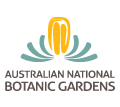
Australian National
Botanic Gardens
In Flower This Week
A weekly news-sheet prepared by a Gardens volunteer.
Numbers in brackets [ ] refer to garden bed 'Sections'. Plants in flower
are in bold type.
|
|
In Flower This WeekA weekly news-sheet prepared by a Gardens volunteer. |
21 November 2003
So much to see! Let’s start by looking at some of the variety in Grevillea, the third largest genus in the Australian flora. Many species produce huge quantities of nectar and attract many birds, especially honeyeaters.
 |
|
Grevillea johnsonii
- click for larger image
|
Strolling along Banks Walk from the Visitor Information Centre, above the stairs to the car park, Grevillea johnsonii [Section 174] has long, thin green leaves and pink/cream flowers. Further back in the bed, Grevillea ‘Ned Kelly’ [Section 174] has divided leaves and large sprays of orange/red flowers, while Grevillea alpina (Warby Range form) [Section 174], behind the seat, has small greyish leaves and red/yellow flowers. Opposite, Grevillea tripartita subsp. macrostylis [Section 210] from Western Australia, has prickly holly-like foliage and elongated orange/red flowers. Opposite, another WA species, Grevillea dielsiana [Section 174] has open prickly foliage and conspicuous orange red/yellow flowers. Then another cultivar, Grevillea ‘Flame ’n Beauty’ [Section 174] has greyish leaves, and lovely red flowers.
Following the road to the left, in the shade above the rainforest gully, Grevillea barklyana subsp. barklyana [Section 125] has large soft leaves and pink/mauve toothbrush flowers. Around the corner and across the road, Grevillea rosmarinifolia ‘Rosy Posy’ [Section 182] has sizeable clusters of waxy pink flowers and fine dark green leaves.
Turn right beside Grevillea ‘Poorinda Royal Mantle’ [Section 124], a spreading, prostrate groundcover with red toothbrush flowers. Grevillea ‘Crimson Glory’ [Section 124] is low growing with cyclamen toothbrush flowers and indented, slightly prickly leaves. Grevillea ‘Poorinda Leane’ [Section 124] displays its apricot flowers and stubby green leaves. Turn left opposite a spectacular brittle gum (Eucalyptus mannifera), for Grevillea ‘Scarlet Sprite’ [Section 119] with crowded, fine leaves and bright red/cream flowers. Finally, Grevillea aspleniifolia [Section 120] with its spreading branches and long mauve/pink toothbrush flowers must be a wonderful refuge for birds.
Now for some non-Grevilleas: the large-leafed creeper Kennedia nigricans [Section 6] has unusual black and yellow flowers. Callistemon sp. [Section 110] has profuse bright red brushes, while Derwentia perfoliata [Section 110] has greyish stem-clasping leaves and bright blue flowers. Turn left below the rockery and follow the main path to the Wollemi pine in its wrought-iron cage. Opposite, tiny male cones on the prostrate conifer Podocarpus lawrencei [Section 80] have a purplish tinge. Further along bright cream new leaves on Podocarpus elatus are very showy.
Many orchids are flowering on the right of the entrance to the rainforest. After crossing the bridge, turn left, then take the steps to the right through an archway of white-flowered Acradenia euodiiformis [Section 64 & 65]. Enjoy the quiet road leading down between the rainforest and the rainforest verge past a bed with Pacific Island flora. Take the second stairs down to the main path, pausing at the pink-orange flowers of Rhododendron laetum [Section 213]. This is a Papua New Guinea species similar to our North Queensland species Rhododendron lochiae . Turn right onto the main path, enjoying many more lovely flowers on the way back to Banks Walk, including a dainty, white-flowered Derwentia decorosa [Section 210].
Kath
|
Return to: |
Search |
Previous
|